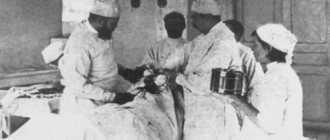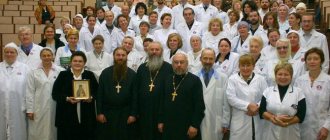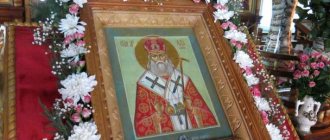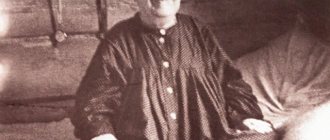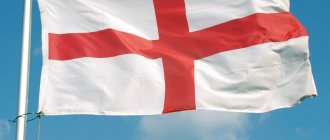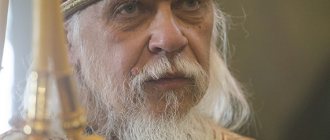There is a category of people who categorically refuse to go to doctors, even if they feel very bad. There are people who do not attend preventive examinations based on the principle: “If nothing hurts, then everything is fine with me.” Are they choosing the right tactics?
- Why you should visit a doctor
- What can happen if you neglect medical care?
- Reasons for fear of visiting doctors
- How often to visit a doctor
- Are men more afraid of doctors?
Apostle and Evangelist Luke (1st century)
Luke, the beloved physician, greets you, the Apostle Paul writes about him in his letter to the Colossians (Col 4:14 ). Luke, an apostle from the 70s, wrote one of the four Gospels under the leadership of the Apostle Paul and the book “The Acts of the Holy Apostles.” According to legend, he was the first to paint icons of the Mother of God. In honor of the evangelist, another holy doctor received his name in monasticism - Archbishop Luke (Voino-Yasenetsky). The Apostle Luke suffered martyrdom: he was hanged on a tree.
Saints unmercenary Cosmas and Damian (IV century)
The Orthodox Church honors the memory of three pairs of saints with the names Cosmas and Damian: all of them became famous as unmercenary doctors. The most revered are Cosmas and Damian of Asia (IV century), siblings. Raised by a Christian mother (Reverend Theodotia), they healed the sick for free and, in addition, they themselves searched for and treated wild animals, which then followed them without fear. At the end of his life, Damian broke his vow of free healing: a hopeless patient who had recovered begged him in the name of the Holy Trinity to take three eggs as a gift for healing. Hearing that his brother had neglected his vow, Cosmas bequeathed that he and Damian should be buried separately. After the death of the brothers, God revealed to people that Damian accepted the gift for the sake of love for the Creator, and not out of self-interest, and the holy brothers were buried together.
Why go to the doctor?
Of course, the first answer to this question is simple: to get treatment. However, it is no secret that official doctors are far from angels. It happens that once in his life a person has encountered rudeness or incompetence on the part of a doctor, and after that he categorically refuses any medical help. This is a fundamentally wrong approach: doctor differs from doctor, just like person differs from person to person, so to be offended and follow the principle in this case is simply stupid and frivolous.
It doesn’t hurt to go to the clinic at least once a year for a routine preventive examination. Urine, blood, ECG and other tests can help identify serious diseases in the early stages of their development and prescribe treatment that will be effective. In addition, every sane person probably knows all of his or her own “chronic illnesses.” They also need to be monitored periodically, preventing them from exacerbating and treating radiculitis in a timely manner with a good neurologist or osteopath. It happens that a medicine prescribed by a doctor several years ago to treat some chronic pathology, for some reason, stops working. It is imperative to come to an appointment with your doctor, undergo another examination and examination in order to receive a new drug that is suitable in terms of the mechanism and intensity of action.
Holy unmercenary martyrs Cyrus and John (late 3rd - early 4th centuries)
The holy unmercenary Cyrus was a famous doctor in the city of Alexandria, he treated all the sick for free, including healing mental illnesses. At the same time, the holy doctor was not afraid to preach the Gospel. During the persecution of Emperor Diocletian, Cyrus retired to the Arabian desert, where he became a monk and continued to heal people who came to him. One day the doctor-monk was found by the warrior John, who wished to become his follower. After some time, the teacher and student went to Egypt together to support a Christian woman named Athanasia, who was imprisoned with her three daughters. Cyrus and John were captured and tortured in front of Athanasia. But neither she, nor her children, nor the martyrs themselves renounced Christ and were executed.
“Is it better not to go to doctors?”
Alas, the rampant use of “psychics”, “magicians” and “healers” of all stripes in our country sometimes plays a fatal role in people’s lives. It is no secret that among the colorful “healing galaxy” there are frankly unscrupulous and incompetent people who sometimes even dissuade their clients from visiting professional doctors. Unfortunately, the situation in Russian healthcare sometimes also leaves much to be desired, but this does not mean that you need to harm your health and listen to the “recommendations” of dubious persons who do not have a medical education.
It also happens that suspicious and superstitious people who firmly believe in the “evil eye” or “spoilage” go to healers and fortune-tellers for months and years, repeating, like a mantra, the well-known motto: “It’s better not to go to doctors: they will heal and torture you, but Baba Masha definitely said that I have damage, and not an ordinary illness.” Unfortunately, it is these people who most often die from cancer, strokes, heart attacks and other systemic diseases - only because they did not receive timely treatment and help.
Holy Great Martyr Panteleimon (III century)
Born in Bithynia (Asia Minor) in the family of a noble pagan and a secret Christian (Saint Evvula). He studied medicine with the famous physician Euphrosynus and subsequently became a court physician under Emperor Maximian. The life of a handsome and successful young man was turned upside down by a meeting with Presbyter Ermolai, who subsequently baptized him. After the death of his father (who was baptized at the end of his life), the future great martyr devoted himself to helping the sick and poor. He treated everyone free of charge, invariably praying for the sick, and visited prisoners in prison. His success as a doctor became the envy of his colleagues in the profession - they reported to the emperor, the persecutor of Christians, that Panteleimon confesses Christ and visits his fellow believers in prison. An arrest followed. At the same time, the teacher of Panteleimon, the martyr Ermolai, was tried and executed, along with two other presbyters. The young doctor was tortured and in the end also beheaded with a sword. The Holy Great Martyr and Healer Panteleimon is revered in the Church as the patron of doctors and intercessor for the sick.
1. Holy Great Martyr and Healer Panteleimon
In the Russian Orthodox Church this saint has been venerated since the 12th century. Named Pantoleon from birth, he was born into the family of a noble pagan and a Christian woman. When the young man grew up, he began to study the medical profession from the famous physician Euphrosynus. Pantoleon later became the emperor's court physician. The holy martyr Ermolai had a great influence on the young man: he told him about the Christian faith, and later baptized him. After the death of his father, whom the saint had recently persuaded to accept Christianity, Pantoleon began to help all those in need free of charge.
He healed the poor and the poor, as well as those in prison. The envious people reported to the emperor about the miraculous healings, and that they were accomplished with the help of the Christian God, and Pantoleon himself was a Christian. The ruler tortured the holy healer for a long time so that he would renounce his faith. But the inhuman torture did not bring any harm to the great martyr.
Seeing this miracle, many pagans converted to Christianity. Then the distraught emperor ordered the young man's head to be cut off. The executioners refused, but at the request of the saint himself, they did it with tears in their eyes. During all the torment, the Lord himself named the passion-bearer Panteleimon (“much-merciful”). The relics of the holy healer were dispersed in pieces among all Christian peoples. The Great Martyr Panteleimon is the patron saint of doctors and one who asks for all those who are sick; they pray to him asking for deliverance from various diseases and ailments.
2. Saints Cosmas and Damian
In Orthodoxy, several saints with the names Cosmas and Damian are honored: Asian, Arabian and Roman. The most famous of them are the Asians, siblings raised by a Christian - the Venerable Theodotia. The saints studied medicine from an early age in order to relieve the sick from their ailments - for this God endowed them with the gift of healing.
The brothers treated people of different classes absolutely free of charge. Miraculously, they could cope with any ailment. In addition, Kosma and Damian treated sick animals; according to legend, one healed camel even gained the gift of speech.
The saints were never separated, but one day one of the brothers broke his vow of free healing by taking three eggs as a gift from a healed woman. Having learned about this, Kosma bequeathed to bury him separately from his brother. When people learned that Damian had taken the reward through God's providence, they buried the saints together. A church was built at the site of their burial, to which sick people came from all over the area to pray to the saints for healing. In Orthodoxy, the unmercenary saints Cosmas and Damian are considered the patrons of children. Through their prayers, spiritual and physical ailments are healed.
3. Martyr Antiochus of Sebaste
The holy physician Antiochus of Sebaste was the brother of the holy martyr Plato. When the pagans learned about the healer’s Christian faith, they summoned him to trial. Through the prayer of the martyr Antiochus, the idols that the emperor had called upon him to worship crumbled to dust.
The saint was thrown into boiling water and a pit with wild animals, but miraculously he remained unharmed.
After this, the martyr was beheaded, but blood flowed from the wound along with milk. Antiochus of Sebastia wandered through the cities and treated the sick, without demanding a reward for this. The memory of the holy martyr began to be celebrated back in the 7th century; he grants healing to those who turn to him in prayer and is the patron saint of doctors.
4. Venerable Agapit of Pechersk
As a resident of the Kiev-Pechersk Lavra, Agapit of Pechersk was the first famous holy healer in Rus'. The saint himself was healed of his illness when he came to the cave to the Monk Anthony. After being tonsured to the monastic rank, Agapit of Pechersk was healed, but wished to remain with his mentor.
One of the miracles performed by the holy healer was the treatment of Prince Vladimir Monomakh with an infusion of herbs. But, of course, the healings took place primarily through the prayers of Saint Agapit to the Lord.
When the healer became famous, his rival, a famous Kiev doctor, wanted to poison him. But the poison had no effect on the Monk Agapit. And now many miraculous healings are taking place near the relics of the saint. They pray to him for deliverance from diseases of the spirit and body. Having left behind many disciples who also became saints, the Monk Agapit of Pechersk is the patron of medicine.
5. Apostle and Evangelist Luke
One of the seventy disciples of Christ - Luke - was a doctor by first profession; later he became an icon painter, preacher and theologian.
When the Lord sent the Apostle Paul serious illnesses, Saint Luke’s medical talent came in handy. He prepared and gave medicine to the apostle, easing his torment, for which he called him “beloved physician.”
The prayerful intercession of the holy apostle and evangelist is asked for various diseases, but especially for eye diseases.
6. Saint Luke of Crimea (Voino-Yasenetsky)
The holy healer closest to us in time was St. Luke of Crimea. He was born in 1877 in Kerch into the family of a Catholic and an Orthodox Christian, but his father did not impose his religious worldview on him. In his youth, the future saint often thought about what he wanted to become: the choice was between an artist and a doctor. A sincere desire to help people and save them from illness determined the young man’s profession. During the Russo-Japanese War, Valentin (this was the saint’s secular name) went to the hospital as a surgeon. There he saved many lives, gained vast experience, and also found a life partner.
Later, he continued his activities as a zemstvo doctor and surgeon, while participating in theological debates and refuting the theses of scientific atheism.
Due to the shortage of doctors, the saint was not persecuted in the post-revolutionary period. After the wife of the future saint died of tuberculosis, he became a priest and then took monastic vows. But soon a wave of arrests overtook him: for many years he was sent into exile, where he continued to fulfill his medical and pastoral duties. The saint himself suffered from illness: after experiencing a fever, he became blind in one eye. During the Great Patriotic War, he treated the wounded on the battlefields. The attitude of the authorities towards the saint softened - for scientific discoveries and enormous contributions to the development of surgery, the then famous doctor and archbishop was awarded the Stalin Prize.
By the end of his life, the healer was completely blind, but continued to be of good spirit. He left behind many scientific and theological works. Until now, many miraculous healings occur at the holy relics of St. Luke of Crimea.
Of course, prayer addressed to holy healers has special power. They ask for us and our loved ones before the Lord, and we should not forget that we are healed only by the will of God Himself. These chosen saints intercede for all those who suffer without exception, but the miracle of healing depends primarily on the will of the Lord and the faith of the person asking.
Prepared by Anastasia Korneva
Martyr Orestes (late 3rd - early 4th centuries)
He was a famous doctor in Cappadocia. A Christian since childhood, he openly preached Christianity during persecution. During interrogation by the royal dignitary, Orestes showed extraordinary courage: when asked to give his name, he replied that his name was Christian, and it seemed to him higher than the name given by his parents at birth. Firmly refusing to renounce his faith, the holy doctor endured many tortures: 40 soldiers, replacing each other, tortured him. Then the martyr was tied to a wild horse and dragged along the ground until Saint Orestes died.
Why are they afraid to go to the doctor?
Fear of visiting doctors is often associated with the fact that a person “doesn’t like to sit in line,” “go through procedures and tests because it’s painful and unpleasant,” and so on. However, if we proceed from this principle, you can harm yourself much more, and the pain and suffering, which will certainly increase due to a progressive disease, will be much stronger than the unpleasant sensations that arise when giving injections, FGDS or taking a blood test.
People often tend to believe numerous stories about medical negligence. Of course, such cases, alas, do occur, but not to the extent that some particularly “diligent” journalists try to exaggerate. Before going to the clinic, it is better to set yourself up in a positive mood, understanding that ignoring alarming symptoms can lead to much worse consequences than short-term pain from an injection into a “soft spot”. Promise yourself that after a successful outcome of some unpleasant procedure, you will definitely reward yourself - for example, by going to a good restaurant, cafe, or just shopping.
Martyr Diomede (III century)
A doctor by profession, he healed not only physical, but also mental illnesses. Traveling a lot, Diomede preached Christ, converting and baptizing pagans. One day a doctor came to Nicaea, and the pagan emperor Diocletian sent soldiers to arrest him. But he died a holy, peaceful death on his way back from Nicaea. According to the life, having found his body, the soldiers cut off the saint’s head as proof of the fulfillment of the emperor’s order, but they immediately became blind. Diocletian ordered the head to be taken back to the body: the soldiers who carried out the order regained their sight. The name of the martyr Diomedes is remembered during the sacrament of Blessing of Unction (Unction).
Text of the book “Holy Healers”
Timofey Veronin Holy Healers
Recommended for publication by the Publishing Council of the Russian Orthodox Church
IS 14
© Publishing House of the Moscow Patriarchate of the Russian Orthodox Church, 2014
© Veronin T., text, 2014
* * *
Holy Father, Physician of souls and bodies, having sent Your only begotten Son, our Lord Jesus Christ, who heals every ailment and delivers from death, heal also Your servants (names) from evils relieve their bodily and spiritual infirmities, and revive them by the grace of Thy Christ;
through the prayers of our Most Holy Lady, Theotokos and Ever-Virgin Mary; intercession of the honest Heavenly Forces without flesh; by the power of the Honest and Life-giving Cross; the honest, glorious prophet, Forerunner and Baptist John; holy glorious and all-praised apostles; holy glorious and victorious martyrs; our venerable and God-bearing fathers; saints and healers of the unmercenary Cosmas and Damian, Cyrus and John, Panteleimon and Ermolai, Sampson and Diomedes, Photius and Anicetas; the holy and righteous Godfathers Joachim and Anna and all the saints. For You are the Source of healings, our God, and we ascribe glory to You, with Your Only Begotten Son and Your Consubstantial Spirit, now and ever and unto the ages of ages. Amen. Prayer of the Sacrament of Unction
Part one Holy healers of ancient times
Despite the ailments
In a rural church far from big cities, the Sacrament of Unction was celebrated during Great Lent. It’s also a long way from the nearest villages, but still, under the modestly restored vaults, in front of the poor, ingenuous iconostasis, several dozen parishioners gathered, all old rural workers. The Russian soil was ingrained into their wrinkled hands forever, and their backs were forever bent under the weight of many years of peasant work. They habitually overcame difficult paths among snow-covered fields, despite sore legs and other ailments. Because here, in this beloved church, a window opens for them into a world of eternal joy and peace. To the world where their fathers, grandfathers and great-grandfathers went, who rested right there, in a modest cemetery behind the fence.
The caring priest set up benches in the church, knowing how difficult it was for these seventy-eighty-year-old old women to endure long service. And they, somewhat guiltily, sat on the benches and listened to the prayers of the Church and the Gospel readings, which the priest joyfully and clearly explained to these ordinary people every time.
And then he said the prescribed prayer, asking the Heavenly Father to come to these humble servants of His, to heal their weaknesses and ailments with the prayers of the unmercenaries and healers Cosmas and Damian, Cyrus and John, Panteleimon and Ermolai, Sampson and Diomedes, Photius and Anicetas.
These ancient names were heard many times under the arches of the temple. And together with the sounds of their names, those to whom these names belonged entered the poor dilapidated church, located far from the main roads. They invisibly touched with their prayerful breath and merciful love the backs bent under the weight of many years of work, the calloused hands into which the black earth had eaten, and the feet that had gone through more than one “round-the-world trip” through their own and collective farm arable lands and vegetable gardens.
“O passion-bearing saint and healer Panteleimon, pray to the merciful God that He will grant forgiveness of sins to our souls,” sang a discordant choir consisting of an elderly mother and two old village women.
– Holy unmercenaries and miracle workers, visit our infirmities! – trembling but soulful voices ascended to the dark arches.
And the tears were tangled in the old wrinkles of the faces framed by handkerchiefs. Tears mixed with the blessed oil, and a bright emotion touched these simple hearts. They hardly knew how the healer Panteleimon suffered for Christ, or who Photius or Sampson were, but they undoubtedly felt their closeness, their warm intercession. And they repeated after the priest the names of people who lived in the distant, distant years in the Roman Empire and ascended to God in order to remain forever contemporaries of all who call upon them in their prayers.
We are completely different. Our hands do not know the black earth, our backs are not used to bending over the beds, we are given other illnesses and worries. But we also come to the Unction of Great Lent in our city churches and hear the same prayers, the same holy names. But for us, scribes and bookworms, it is still important to know what kind of destinies are hidden behind each name. It is important for us to at least partially get to know Diomede and Sampson, Cyrus and John, Cosmas and Damian, the healer Panteleimon and his spiritual father Ermolai. And also with the holy martyrs Falaley and Tryphon. Therefore, we want to tell you something about them that, perhaps, will make their images more visible and alive. And then we will be able to sincerely and warmly pray to these great healers so that they will come to our aid in moments of trial and in times of physical and mental illness, from which may the merciful Lord protect us.
Holy Great Martyr and Healer Panteleimon
A bright young man with curly black hair and clear, pure eyes - this is how the healer Panteleimon was remembered by a very young woman, Agnia Polikarpova. She was left alone, helpless, with a newborn baby. Tormenting headaches deprived her of strength and plunged her into a semi-conscious state. In rare moments, when the baby fell asleep and the pain subsided, she grabbed the book that had recently been given to her - the life of the holy healer with his tiny image. She peered into his face, begged, cried. The pain came again, the baby woke up, but there was no strength to get out of bed or approach him.
And one day someone silently entered her room, gently bent over the crying baby, and Agnia recognized this black-haired young man with clear eyes. The baby fell silent. And then the healer approached the patient. Silence and gentle warmth blew over her. “And the most tender mother cannot protect her little one the way he protected me these days,” Agnia later wrote.
Health returned to her, and the warmth of that mysterious meeting remained in her heart forever.
A black-haired young man in ancient clothes, with a small reliquary in one hand and a tiny spoon in the other, he looks at us from his icon in every church. We bring our prayers, complaints, and light candles to him.
- Saint Panteleimon, I ask you, please pray to God for the healing of my son Semyon...
- Great Martyr Panteleimon, help my Dima recover...
“I ask you to help heal my grandson Ilya...” someone fervently prays in front of the icon of the healer.
And the secret sighs of souls are heard in these simple requests.
“Saint Panteleimon, thank you for helping, for hearing my prayers,” a new voice thanks the saint.
Year 2000 from the Nativity of Christ. There is a long line winding towards the Cathedral of Christ the Savior in Moscow. Hour after hour, people stand, breaking out of everyday reality, rushing to the sky. After all, there, in the Temple, in a small silver-plated ark, is the honest head of the one who was once beheaded by Roman soldiers for his loyalty to Christ. People go to a healer with illnesses and everyday needs in order to alleviate, help, arrange, they take their everyday worries to the Temple, to the holy inhabitant of the eternal world, and that means they are also drawn from the earth, from the vanity of vanities, from the depths of the sea of life - to sky.
A simple Russian peasant from the year before last, the nineteenth century. The illness confined him to bed. Day by day it got worse. Pain, insomnia, moaning. The wife, exhausted by her husband’s suffering, wanted to take him to the hospital. But what do doctors and hospitals mean to a rural resident of that time? Only torture, most often with ineffective medical procedures, and also money. Those last pitiful savings that are hidden in the most secluded corner in a canvas bag...
“No, mistress, the doctors will no longer help me, I have only one doctor,” and the patient pointed to a small paper icon of the healer Panteleimon, which he once bought in Moscow in the famous chapel on Nikolskaya.
“Give it to me,” and he pressed the cheap icon to himself. “Help me, holy healer,” the patient whispered, and the long-awaited dream came to him.
And in the dream, the peasant was sitting on a bench in his hut. He knew he was sick, but he felt calm and good. The sun flooded the village street. The chickens pecked peacefully at the roadside soil. And suddenly a carriage drove up silently, easily, over the bumps of the rural road. No one had ever seen such carriages in their wilderness. The door opened slightly. There were three people there. Two elders, and the third... Such a familiar, clear young face and strange old clothes! Exactly like on the paper sample! The young man got out of the carriage and entered the hut. He sat down on the bench next to the patient. He hugged him like a friend, like a father.
“Well, here I am, your doctor, hello, you called me,” a quiet voice sounded. And the sick man clung to him, and warmth, joy, inexplicable bliss filled his soul.
“I’m healthy, mistress, you hear, I’m healthy,” the awakened peasant said cheerfully. On the floor, a kitten played with a ray of sun, and in the heart of a recent patient, a light of another, eternal light burned.
Summer day in pre-revolutionary Moscow. According to the old style - the end of July. Nikolskaya Street, which leads to Red Square, is crowded with people. Thousands and thousands of people are walking and singing. There are, of course, more gray common kaftans and women's scarves, but there are also frock coats and elegant dresses. Moscow honors its beloved healer, the meek Great Martyr Panteleimon.
For convict brands, For every kind of illness - Baby Panteleimon We, healer, have -
This is what Marina Tsvetaeva wrote a year before the revolution.
Here, on Nikolskaya, to the majestic chapel, almost a cathedral, Russian people came every day. They carried their illnesses and sorrows to the image of the saint with a particle of his relics brought from Athos. The blessed elder Agathoclius met pilgrims and petitioners and anointed them with oil. People came here from all over Russia. Everyone knew the place: go through the gates of the Kitai-Gorod wall, pass the squat Church of the Vladimir Icon - and then you will find yourself near the doors from behind which flows the chant of the next prayer service.
After the revolution, one Jew fell ill with cancer, and the doctor gave him several weeks to live. He and his wife were driving from an expensive hospital along Nikolskaya Street in despair. Suddenly the patient asked to stop the stroller near the chapel.
- I have to go there.
“But you are of a different faith,” the wife objected.
– But I feel an imperious call, I cannot resist. “He ran into the chapel and for the first time in his life fell to his knees in front of a Christian shrine. Tears prevented the words of petition from being whispered.
A few weeks later, an elderly man came to one of the churches near Moscow.
“I’m a Jew, but I want to be baptized,” he told the priest. - Because your saint gave me health. I believe in your God.
Meanwhile, the 1920s, the Soviet years, passed. It became increasingly dangerous to be a Christian. But the holy healer turned the soul of this man, brought him into his chapel, gave him health and revealed Christ. And a few years later, the beautiful chapel, along with the fortress wall and several ancient buildings, flew into the air. The roar of collapsing debris swept across Red Square, hit the walls of the Kremlin and flowed towards the river. There were alarming ripples across the water. It was as if someone was carefully walking along the surface of a river.
And where the chapel stood, on the corner of Bogoyavlensky Lane and Nikolskaya Street, for a long time there was a small park. Trees, grass. And then they built a new shopping center here, of which our era has produced many. Anxious shoppers rush past the windows of fashion stores. Mobile phones whistle, packaging bags rustle, white-toothed beauties and handsome men, intoxicated with the bliss of acquiring new things, look out from advertising posters. But maybe even now - in this place, if you stop, if you listen, you will hear someone’s prayerful whisper, crying, singing. After all, he still stayed with us, did not leave, “baby Panteleimon,” the healer of “all adulation.”
* * *
...When he was very young, his mother often pronounced the name of the Christian God over him. If he happened to be sick and his legs and arms ached from the heat, she made the sign of the cross over him. And when he recovered, she sat with him in the garden of their rich villa in the Asia Minor city of Nicomedia and talked about how the Son of God was crucified and how, on an early spring morning on the third day after His death, He appeared first to women, then to disciples, and finally to before their eyes he ascended into heaven.
“He’s waiting for us there, son,” the mother said.
The blue sky shone through the branches of the peach trees. And the boy looked for a long time into the shining gaps.
And then my mother died.
Years later, his father sent him to study the art of medicine. He prayed with his father to Jupiter and Diana. His teacher Euphrosynus zealously made sacrifices to Asclepius. But the azure that shone through the green of the trees stirred the boy’s soul. Looking at the sky, he often remembered his mother, and a vague anxiety crept into his heart when his father lit lamps in the home idol.
The boy quickly achieved success. Emperor Maximian himself, who visited Nicomedia, drew attention to him. He was destined for a court career. Efrosin was pleased with Pantaleon. Yes, that's what his father called him. “Like a lion in everything,” this name meant. His father wanted to see in him a strong, zealous subject of the great empire, faithful to the civic valor of his ancestors and the greatness of their powerful gods.
But everything in his life turned upside down after he heard his name on the corner of an unpaved alley and a large street. Every morning he went there to see his teacher and did not pay attention to the elderly man who was digging something in the garden or simply sitting at the threshold of his modest one-story house.
“Pantaleon,” this man said, and the young man stopped. The stranger's beard was streaked with gray, and his thin hands rested peacefully on his knees. And the eyes were simple and wise.
“I know you are a worthy student of the famous doctor.” But do you know who the true Doctor of all people is?
“No,” answered Pantaleon with excitement, as if expecting something.
“Christ,” the man said quietly.
The named Name instantly revived in the young man’s memory the azure shining through the branches of the peach trees, and the mother bending over the crib, and the mysterious warmth of the mother’s prayer and blessing.
Pantaleon often came to this man afterwards. It turned out that he was a priest of the persecuted Christian Church. His name was Ermolai. In the back room of a small house, Pantaleon heard about the events that took place in distant Galilee three hundred years ago. About how the Savior of the world was born in a cave on a cold night. How he later went out to preach, healing and comforting people. How He raised a paralytic from his bed, restored sight to a blind man, how He raised a dead girl, the daughter of the ruler of the synagogue, and a young man, the only son of a widow, and His friend Lazarus.
“Is it really that the faith of my fathers is a false faith, and the truth here is in the words of this quiet man?” - Pantaleon often thought and remembered his mother. Deep in thought, he often now wandered around the city after classes, only returning home in the evening.
One day the young man went out to a vacant lot and near the road, among the stones and dry thorns, he saw a snake. She curled up on the stone and hissed, raising her head. Her cold eyes sparkled ominously, and Pantaleon stepped aside in fear and suddenly tripped over something. He thought it was a lump of earth or a lump, but, looking back, he saw a pale boy. He was lying on the ground, his head lifelessly thrown back, his thin arms spread out. The face was whiter than canvas, the lips were limply parted, the motionless eyes shone with a glassy, lifeless coldness. There could be no mistake, the boy was dead. On the leg, just above the ankle, there was a tiny bite mark; the deadly snake venom stopped the little child’s heart. Forgetting about the danger (and the snake continued to watch the man with the same cold attention, ready to attack), Pantaleon approached the boy. And I felt piercingly, painfully sorry for this child. He was not even ten years old. His family, brothers, sisters live somewhere nearby. Mom is waiting for him and probably thinks that her son is playing with his friends again, and is already starting to get angry and does not know what grief is very close to her. And Pantaleon’s heart was filled with determination.
- No, I don’t want this death, this grief. And the One about whom Ermolai told me, Whom my mother called at night over my crib, He also does not want this grief. “He wants and can help,” Pantaleon whispered.
His first prayer flowed through his soul - a prayer of mercy and compassion:
- Lord of Ermolai and my mother, You came to our land, and they say about You that during Your life You healed and resurrected. If this is so, if Ermolai is right, and my father and my teacher are deceived, create a miracle, raise this boy, return him to his mother, and stop the snake, let it no longer sow death!
How much strength the young man gave to this short prayer! Sitting down on the ground, he hid his face in his hands, and the menacing hissing head of the snake flashed before him again. And he froze. No, he didn’t expect anything more, didn’t ask for anything, but it was as if he had forgotten himself for a moment, lost himself, lost his sense of reality.
“Oh, look what happened to this reptile,” a cheerful boyish voice suddenly rang in his ear. - Is that how you call her? But she, it seems, bit me, but nothing.
The same boy stood in front of him, alive, no longer so pale. He smiled, chatted, and near the stone lay a snake, cut in half. Only by whom?
Pantaleon jumped to his feet, joy flooding his heart.
“That means Ermolai is right, that means Jesus is God!” - he shouted and hugged the boy, and although he did not understand anything, he also hugged Pantaleon. “Run, run to your mother, she’s looking for you, you’re delayed, do you hear,” the young man said hastily. And the boy actually ran, but Pantaleon did not run, but flew to the house on the corner of a quiet lane and a large street.
On this day a new person was born. In the back room of his modest house, Father Ermolai baptized Pantaleon. A lamp was burning quietly in a low room. It was cold. The coals were smoldering in the hearth. But the young man was warmed by an unearthly warmth. He froze, feeling with joyful amazement Someone’s sweet, unearthly touch. Someone was now in this room, Someone visited this tiny house and entered the young man’s heart with His warm breath.
But how quickly time flew by, how quickly the hour came when Pantaleon was called to the emperor who had arrived in Nicomedia. This was preceded by the healing of a blind man. In the name of Christ, a young doctor cured him. Envious people reported this to the emperor. And now the ruler of the world looks gloomily into the pure, clear eyes of Pantaleon.
- Why don’t you, young man, strive to serve me? Or don’t you want to serve the great empire and the emperor himself? Do you prefer ragamuffins and deceivers? Or maybe you like the tales about the deceiver from Galilee executed on the cross?
“He is not a deceiver, and the stories about Him are not fairy tales,” Pantaleon objected quietly but firmly. -He is the true God.
“Don’t be crazy,” the emperor grinned.
“I’m not crazy, those who don’t recognize the Lord, the Creator of heaven and earth, are crazy,” a young voice sounded firmly under the arches of the palace. – Do you want to see His power and experience the power of the Roman gods? I know you now have a terminally ill servant. Let them bring him here, and let your priests call on their gods to help, may they come to heal him. And then I will call on my God.
Maximian was silent for a long time. Then he ordered:
- Carry it.
A man lying exhausted on a stretcher. He has been bedridden for several weeks. A lock of hair stuck to his pale forehead. He breathes hoarsely, and his bloodless lips barely move. Loud prayerful exclamations of the priests resound throughout the building. It smells of incense and then of fried meat. A young lamb is smoking on the altar. But the patient only coughs, choking from the smoke flowing towards him.
And next to the stretcher is Pantaleon. He does not light a sacrificial fire, does not stretch out his hands to the sky with loud cries. He leans over to the patient and takes his thin, long fingers into his soft hands.
“Lord, hear my prayer and have mercy on this suffering creation of Yours,” he says in a quiet voice. Only the emperor and a few close associates can hear Pantaleon. The rest freeze in silence. Silence falls on everyone, fills the chambers of the palace, silence asks for every heart, even in the heart of the cruel Maximian. And in the silence you can hear the stretcher creaking as the patient rises to his feet. Pantaleon gives him his hand, and they walk, walk through the hall, and silence walks with them, and no one can break this silence until a sharp sound is heard. This is the emperor striking the stone slabs with his staff in rage.
By order of the king, the holy healer was dragged to torture. They whittled with iron claws and burned with fire. Then they were given to the lions to eat. The lions licked his feet. They could not, did not dare, harm him in any way. Blood, wounds, burns turned the once beautiful body into a clot of pain. But large, clear eyes looked at the tormentors without malice and even with pity. And when the veil of death began to cloud this pure gaze, when darkness almost completely engulfed consciousness, he saw a radiance. This radiance was approaching and growing. And suddenly a figure appeared that seemed so familiar to Pantaleon... The pain subsided, the screams of the tormentors, the roar of the crowd became barely audible. The one who approached him looked so much like the priest Ermolai. But the priest had just been executed in front of Pantaleon by order of the emperor. However, the facial features are similar. Similar and at the same time different... No, this is not Ermolai. This, this...
“Panteleimon,” a calm, even voice rang out. And the martyr recognized him. After all, this was the same voice that he heard from the pages of the Gospel, when in the cramped room of the modest house of the priest Ermolai, Christians secretly gathered for the Liturgy. In the darkness, only one lamp barely flickered in front of the image of a large fish on the wall, and the priest took out a precious book from its hiding place. He read the words of the Savior, and his voice became different, it was no longer his voice, not the voice of Father Ermolai. Christ himself spoke through his lips...
“Panteleimon,” the sufferer heard again.
The Savior gave him a new name. No, he is not “like a lion in everything,” but “all-merciful” - this is the meaning of the new, true name of the martyr and healer, the name that he received a few hours before his death. A few hours before the sword of a Roman soldier cut off his head.
This name will last through the centuries. It will fly over the borders of the Roman Empire, survive many historical eras and step into our hectic, information-industrial age. Again and again, entering under the arches of our churches, we will involuntarily look for the icon of a black-haired young man with a small reliquary and a tiny spoon in his hands. The light of our candle will caress his thin pale hand. And we will linger for a minute next to his gentle bright face, because we always have someone and something to ask the all-merciful healer and great martyr Panteleimon.
Saints Alypius (XII century) and Agapit (XI century) of Pechersk
The inhabitants of the Kiev Pechersk Lavra were the first famous holy doctors in Rus'. The Monk Agapit, in particular, became famous for healing Vladimir Monomakh, the future great prince of Kyiv, by sending him an infusion of herbs. Once, out of envy, a well-known doctor in Kyiv tried to poison a monk-healer, but the poison had no effect. Subsequently, the envious man repented and took monastic vows.
The Monk Alypius, in addition to the gift of healing, is known as an icon painter. One of the icons of his letter - the Svensk Icon of the Blessed Virgin Mary - is now kept in the State Tretyakov Gallery.
Righteous passion-bearer Evgeny (Botkin) (XX century)
Son of the famous Russian doctor Sergei Petrovich Botkin (physician to Alexander II and Alexander III). He graduated with honors from the Military Medical Academy and worked at the Mariinsky Hospital for the Poor. With the outbreak of the Russo-Japanese War (1904), he became a volunteer in the army and headed the medical unit of the Russian Red Cross Society. In 1908 he was invited to the family of Nicholas II as a physician. He remained in this position until his death - in 1918 he was shot along with the royal family in Yekaterinburg. In 2021, he was canonized by the Russian Orthodox Church.
Saint Luke (Voino-Yasenetsky) (XX century)
He was born into the family of a Catholic pharmacist, but was raised by his mother in the Orthodox faith. In 1903 he graduated from the Faculty of Medicine of Kyiv University. During the Russo-Japanese War (1904), he headed the department of surgery at the Kyiv Red Cross hospital in Chita. He married sister Anna, who bore him four children and died of tuberculosis in 1919. After some time, he was ordained deacon, then presbyter. In 1923, Valentin Feliksovich Voino-Yasenetsky was tonsured a monk with the name Luke in honor of the evangelist doctor. That same year he was ordained bishop, after which he was arrested on the standard suspicion of “counter-revolutionary activities.” A series of arrests and exiles began, which lasted 11 years, while the bishop did not stop serving and treating people, writing medical and theological works. In 1946, he was awarded the Stalin Prize for scientific developments in the field of medicine. Saint Luke spent the last years of his life as Archbishop of Crimea, saving the lives and souls of people to the end. In 2000, the Council of Bishops of the Russian Orthodox Church glorified the holy confessor Luke among the host of new martyrs and confessors of the Russian 20th century.
